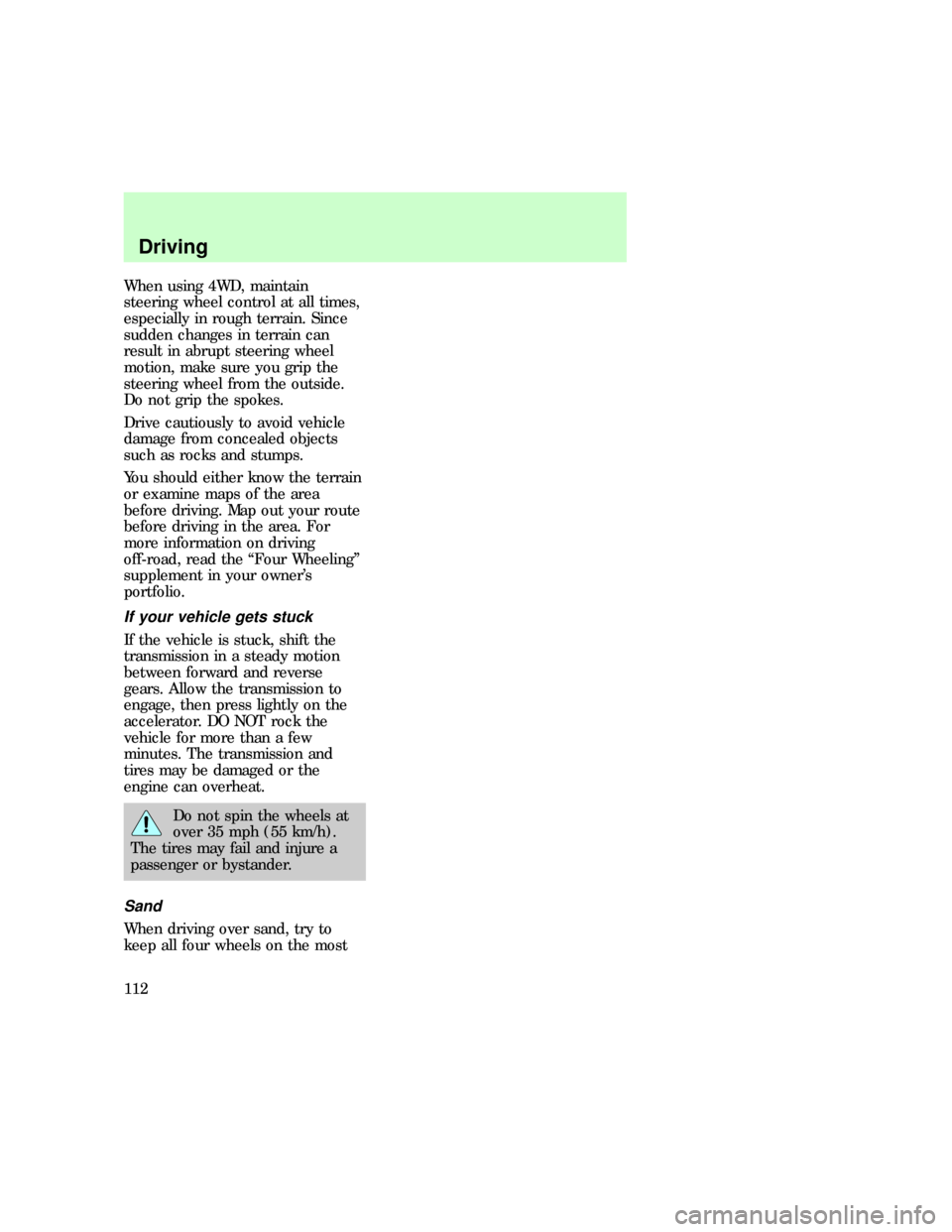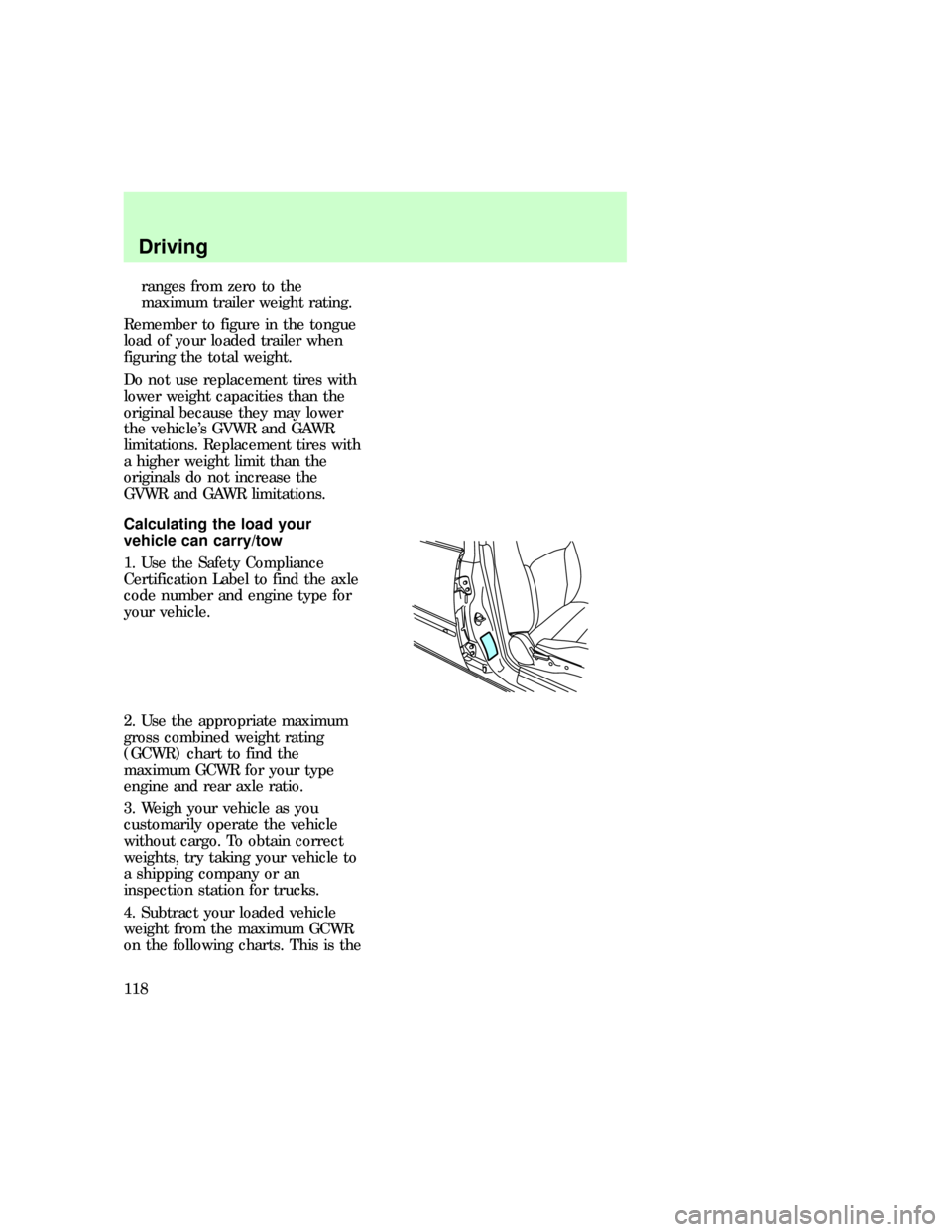Page 111 of 219

When using 4WD, maintain
steering wheel control at all times,
especially in rough terrain. Since
sudden changes in terrain can
result in abrupt steering wheel
motion, make sure you grip the
steering wheel from the outside.
Do not grip the spokes.
Drive cautiously to avoid vehicle
damage from concealed objects
such as rocks and stumps.
You should either know the terrain
or examine maps of the area
before driving. Map out your route
before driving in the area. For
more information on driving
off-road, read the ªFour Wheelingº
supplement in your owner's
portfolio.
If your vehicle gets stuck
If the vehicle is stuck, shift the
transmission in a steady motion
between forward and reverse
gears. Allow the transmission to
engage, then press lightly on the
accelerator. DO NOT rock the
vehicle for more than a few
minutes. The transmission and
tires may be damaged or the
engine can overheat.
Do not spin the wheels at
over 35 mph (55 km/h).
The tires may fail and injure a
passenger or bystander.
Sand
When driving over sand, try to
keep all four wheels on the most
f12_driving_sand
Driving
112
Page 113 of 219

that could damage drive
components.
If the transmission and transfer
case are submerged in water, their
fluids should be checked and
changed, if necessary.
If the rear axle is submerged in
water, the rear axle lubricant
should be checked and changed, if
necessary. The rear axle is filled
with a synthetic lubricant and does
not normally require a lubricant
change for the life of the vehicle.
Rear axle lubricant quantities
should not need to be checked
unless a leak is suspected.
Driving on hill or slope terrain
When driving on a hill, avoid
driving crosswise or turning on
steep slopes. You could lose
traction and slip sideways. Drive
straight up, straight down or avoid
the hill completely. Know the
conditions on the other side of a
hill before driving over the crest.
When climbing a steep hill, start in
a lower gear rather than
downshifting to a lower gear from
a higher gear once the ascent has
started. This reduces strain on the
engine and the possibility of
stalling.
f12_driving_hill
Driving
114
Page 117 of 219

ranges from zero to the
maximum trailer weight rating.
Remember to figure in the tongue
load of your loaded trailer when
figuring the total weight.
Do not use replacement tires with
lower weight capacities than the
original because they may lower
the vehicle's GVWR and GAWR
limitations. Replacement tires with
a higher weight limit than the
originals do not increase the
GVWR and GAWR limitations.
Calculating the load your
vehicle can carry/tow
1. Use the Safety Compliance
Certification Label to find the axle
code number and engine type for
your vehicle.
2. Use the appropriate maximum
gross combined weight rating
(GCWR) chart to find the
maximum GCWR for your type
engine and rear axle ratio.
3. Weigh your vehicle as you
customarily operate the vehicle
without cargo. To obtain correct
weights, try taking your vehicle to
a shipping company or an
inspection station for trucks.
4. Subtract your loaded vehicle
weight from the maximum GCWR
on the following charts. This is the
f12_calculating_load
Driving
118
Page 118 of 219

maximum trailer weight your
vehicle can tow and must fall
below the maximum shown under
maximum trailer weight on the
chart.
Trailer towing table (F-150 4x2 automatic transmission)
Engine Rear axle
ratioMaximum
GCWR kg (lb)Maximum
trailer weight
kg (lb)Maximum
frontal area
of trailer
m
2(ft2)
Regular Cab F-150
4.2L 3.08 4,077 (9,000) 2,177 (4,800) 5.52 (60)
4.2L 3.55 4,530 (10,000) 2,582 (5,800) 5.52 (60)
4.6L 3.08 4,530 (10,000) 2,582 (5,700) 5.52 (60)
4.6L 3.55 5,209 (11,500) 3,261 (7,200) 5.52 (60)
5.4L 3.08 4,983 (11,000) 2,948 (6,500) 5.52 (60)
5.4L 3.55 5,753 (12,700) 3,268 (8,000) 5.52 (60)
SuperCab F-150
4.2L 3.08 4,077 (9,000) 2,086 (4,600) 5.52 (60)
4.2L 3.08 4,530 (10,000) 2,540 (5,600) 5.52 (60)
4.6L 3.55 4,530 (10,000) 2,491 (5,500) 5.52 (60)
4.6L 3.55 5,209 (11,500) 3,171 (7,000) 5.52 (60)
5.4L 3.08 4,983 (11,000) 2,857 (6,300) 5.52 (60)
5.4L 3.55 5,753 (12,700) 3,628 (8,000) 5.52 (60)
Trailer towing table (F-150 4x2 manual transmission)
Engine Rear axle
ratioMaximum
GCWR kg (lb)Maximum
trailer weight
kg (lb)Maximum
frontal area
of trailer
m
2(ft2)
Regular Cab F-150
4.2L 3.08 2,944 (6,500) 1,041 (2,300) 5.52 (60)
4.2L 3.55 3,533 (7,800) 1,630 (3,600) 5.52 (60)
4.6L 3.08 2,944 (6,500) 997 (2,200) 5.52 (60)
Driving
119
Page 119 of 219

Trailer towing table (F-150 4x2 manual transmission)
4.6L 3.55 3,533 (7,800) 1,587 (3,500) 5.52 (60)
SuperCab F-150
4.2L 3.08 2,944 (6,500) 951 (2,100) 5.52 (60)
4.2L 3.55 3,533 (7,800) 1,540 (3,400) 5.52 (60)
4.6L 3.08 2,944 (6,500) 907 (2,000) 5.52 (60)
4.6L 3.55 3,533 (7,800) 1496 (3,300) 5.52 (60)
Trailer tow table (F-150 4x4 automatic transmission)
Engine Rear axle
ratioMaximum
GCWR kg (lb)Maximum
trailer weight
kg (lb)Maximum
frontal area
of trailer
m
2(ft2)
Regular Cab F-150
4.2L 3.08 4,077 (9,000) 1,995 (4,400) 5.52 (60)
4.2L 3.55 4,530 (10,000) 2,449 (5,400) 5.52 (60)
4.6L 3.08 4,530 (10,000) 2,404 (5,300) 5.52 (60)
4.6L 3.55 5,209 (11,500) 3,084 (6,800) 5.52 (60)
5.4L 3.08 4,983 (11,000) 2,721 (6,000) 5.52 (60)
5.4L 3.55 5,753 (12,700) 3,492 (7,700) 5.52 (60)
SuperCab F-150
4.6L 3.08 4,530 (10,000) 2,313 (5,100) 5.52 (60)
4.6L 3.55 5,209 (11,500) 2,993 (6,600) 5.52 (60)
5.4L 3.08 4,983 (11,000) 2,721 (6,000) 5.52 (60)
5.4L 3.55 5,753 (12,700) 3,492 (7,700) 5.52 (60)
Trailer towing table (F-150 4x4 manual transmission)
Engine Rear axle
ratioMaximum
GCWR kg (lb)Maximum
trailer weight
kg (lb)Maximum
frontal area
of trailer
m
2(ft2)
Regular Cab F-150
4.2L 3.08 2,944 (6,500) 861 (1,900) 5.52 (60)
Driving
120
Page 120 of 219

Trailer towing table (F-150 4x4 manual transmission)
4.2L 3.55 3,533 (7,800) 1,451 (3,200) 5.52 (60)
4.6L 3.08 2,944 (6,500) 816 (1,800) 5.52 (60)
4.6L 3.55 3,533 (7,800) 1,406 (3,100) 5.52 (60)
SuperCab F-150
4.6L 3.08 2,944 (6,500) 771 (1,700) 5.52 (60)
4.6L 3.55 3,533 (7,800) 1,360 (3,000) 5.52 (60)
Trailer towing table (F-250 4x2 automatic transmission)
Engine Rear axle
ratioMaximum
GCWR kg (lb)Maximum
trailer weight
kg (lb)Maximum
frontal area
of trailer
m
2(ft2)
Regular Cab F-250
4.6L 3.31 4,756 (10,500) 2,630 (5,800) 5.52 (60)
4.6L 3.73 5,436 (12,000) 3,311 (7,300) 5.52 (60)
5.4L 3.31 5,436 (12,000) 3,265 (7,200) 5.52 (60)
5.4L 3.73 6,115 (13,500) 3,946 (8,600) 5.52 (60)
SuperCab F-250
4.6L 3.31 4,756 (10,500) 2,585 (5,700) 5.52 (60)
4.6L 3.73 5,436 (12,000) 3,265 (7,200) 5.52 (60)
5.4L 3.31 5,436 (12,000) 3,220 (7,100) 5.52 (60)
5.4L 3.73 6,115 (13,500) 3,900 (8,600) 5.52 (60)
Trailer towing table (F-250 4x2 manual transmission)
Engine Rear axle
ratioMaximum
GCWR kg (lb)Maximum
trailer weight
kg (lb)Maximum
frontal area
of trailer
m
2(ft2)
Regular Cab F-250
4.6L 3.31 3,261 (7,200) 1,179 (2,600) 5.52 (60)
4.6L 3.73 3,533 (7,800) 1,451 (3,200) 5.52 (60)
SuperCab F-250
Driving
121
Page 121 of 219
Trailer towing table (F-250 4x2 manual transmission)
4.6L 3.31 3,261 (7,200) 1,133 (2,500) 5.52 (60)
4.6L 3.73 3,533 (7,800) 1,406 (3,100) 5.52 (60)
Trailer towing table (F-250 4x4 automatic transmission)
Engine Rear axle
ratioMaximum
GCWR kg (lb)Maximum
trailer weight
kg (lb)Maximum
frontal area of
trailer m
2(ft2)
Regular Cab F-250
4.6L 3.31 4,756 (10,500) 2,449
(5,400)5.52 (60)
4.6L 3.73 5,436 (12,000) 3,129
(6,900)5.52 (60)
5.4L 3.31 5,436 (12,000) 3,084
(6,800)5.52 (60)
5.4L 3.73 6,115 (13,500) 3,764
(8,300)5.52 (60)
SuperCab F-250
4.6L 3.31 4,756 (10,500) 2,449
(5,400)5.52 (60)
4.6L 3.73 5,436 (12,000) 3,129
(6,900)5.52 (60)
5.4L 3.31 5,436 (12,000) 3,084
(6,800)5.52 (60)
5.4L 3.73 6,115 (13,500) 3,764
(8,300)5.52 (60)
Trailer towing table (F-250 4x4 manual transmission)
Engine Rear axle
ratioMaximum
GCWR kg (lb)Maximum
trailer weight
kg (lb)Maximum
frontal area of
trailer m
2(ft2)
Regular Cab F-250
4.6L 3.31 3,261 (7,200) 952 (2,100) 5.52 (60)
Driving
122
Page 122 of 219
Trailer towing table (F-250 4x4 manual transmission)
4.6L 3.73 3,533 (7,800) 1,224
(2,700)5.52 (60)
SuperCab F-250
4.6L 3.31 3,261 (7,200) 952 (2,100) 5.52 (60)
4.6L 3.73 3,533 (7,800) 1,224
(2,700)5.52 (60)
TOWING A TRAILER
Your vehicle may tow a class I, II
or III trailer provided the
maximum trailer weight is less
than or equal to the maximum
trailer weight listed for your engine
and rear axle ratio on the above
charts.
Your vehicle's load capacity is
designated by weight, not by
volume, so you cannot necessarily
use all available space when
loading a vehicle.
Towing a trailer places an
additional load on your vehicle's
engine, transmission, axle, brakes,
tires and suspension. Inspect these
components carefully after any
towing operation.
f12_trailer
Driving
123